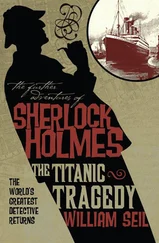The first Titanic film, Saved from the Titanic, appeared after four weeks, in May 1912, with the twenty-two-year-old silent movie star, Dorothy Gibson, who had been on board, playing herself in the dress she had worn in her lifeboat. When, in 1954, Walter Lord was writing his classic account of the wreck, A Night to Remember, he received hundreds of letters in response to his request for memories. In 1958, when the book was being filmed, dozens more Titanic survivors offered the producer, William Macquitty, their help, all believing that they had the ‘correct’ version of events. Many said they had been among the last to leave the ship, and a few proudly claimed to have been the notorious male who had dressed in women’s clothing to ensure his escape. The need felt by the survivors to tell their tales was, from the start, overwhelming and the need of those who were not on board to read their accounts, to see the films, to repeat the experience and work it through, to raise the Titanic and watch her go down again and again is one of the shipwreck’s most peculiar effects. Colonel Archibald Gracie said, after he was rescued by the Carpathia, that the only purpose of the rest of his life was to write an account of surviving the Titanic; when he died eight months later he had completed his task.
Sea stories are as fuelled by jumps as romances are by misunderstandings: whether it is jumping off or onto a ship, a jump contains a concentration of narrative intensity. In Ismay’s jump can be seen his whole life story, but after the inquiries, while passengers and journalists were putting together the most enduring sea story of the last hundred years, he never spoke of his beloved ship again, either in public or in private. And yet from the age of twenty until his death, he scoured the newspapers of the world, cutting out and keeping every article — and there are thousands — referring either to himself or to the White Star Line. Noting in his square, slow handwriting the source and date of each, he pasted them in chronological order into a dozen large, labelled leather-bound ledgers. In this sense, Ismay compiled an edited version of his rise and fall.
Despite his silence, he is someone we already know. Ismay has long inhabited the seabed of our psyches; he has been wandering through our literature for centuries in his various guises. He is Noah, building his ark into which everything comes in pairs; he is Moby Dick ’s Captain Ahab, whose obsession with the great white Leviathan dooms his crew; he is Ishmael — even the name is similar — who ‘alone survived’ when the Pequod went down. Ismay is the Ancient Mariner, cast out from the community of mankind; he is Dr Frankenstein, whose creation became a monster that pursued him across icy wastes; and he is Joseph Conrad’s Lord Jim, who also jumped from a sinking ship and was forced to live on without honour.
There is something peculiar in a small boat upon the wide sea. Over the lives borne from under the shadow of death there seems to fall the shadow of madness.
Joseph Conrad,
Lord Jim
The small boats drifted through the ice. Above them hung a sky of spectacular brilliance: what looked at first like the lights of ships turned out to be falling stars whose reflections shot across the water like cat’s eyes. With the morning sun icebergs the size of islands became glittering gems; some were shades of pink and blue, others were gleaming pyramids of beaten gold. Their ‘awful beauty’, wrote Lawrence Beesley, ‘could not be overlooked’. It was only now that those inside the boats were able to see one another’s faces. A spirited American first-class passenger, who became known as the ‘unsinkable’ Molly Brown, described the morning of 15 April as the ‘most wonderful’ she had ever seen. ‘I have just returned from Egypt. I have been all over the world, but I have never seen anything like this. First the gray and then the flood of light. Then the sun came up in a ball of red fire. For the first time we saw where we were. Near us was open water, but on every side was ice. Ice ten feet high was everywhere, and to the right and left and back and front were icebergs. Some of them were mountain-high. This sea of ice was forty miles wide, they told me.’ Ismay did not remember the sunrise that day.
When the distress call from the Titanic came in, Harold Cottam, the twenty-one-year-old wireless officer on the Cunard Line’s Carpathia, bound from New York to Gibraltar, was preparing for bed but happened to still have the telephone to his ear. Had the message arrived a few minutes later, the Marconi machine would have been turned off. Cottam informed the Captain, Arthur Rostron, who headed to the spot where the Titanic was reported wounded. Rostron had no idea how many passengers he was to pick up, how many other ships would be on the scene, or in what state he would find the great liner. As the Carpathia steamed ahead he prepared a list of orders for his crew:
English doctor, with assistants, to remain in first-class dining room.
Italian doctor, with assistants, to remain in second-class dining room.
Hungarian doctor, with assistants, to remain in third-class dining room.
Each doctor to have supplies of restoratives, stimulants, and everything to hand for immediate needs of probable wounded or sick.
Purser, with assistant purser and chief-steward, to receive the passengers etc., at different gangways, controlling our own stewards in assisting Titanic passengers to the dining rooms, etc.; also to get Christian and surnames of all survivors as soon as possible to send by wireless.
Inspector, steerage stewards, and Master at Arms to control our own steerage passengers and keep them out of the third-class dining hall, and also to keep them out of the way and off the deck to prevent confusion.
Chief Steward: that all hands would be called and to have coffee, tea, soup, etc., in each saloon, blankets in saloons, at the gangways, and some for the boats.
To see all rescued cared for and immediate wants attended to.
My cabin and all officials’ cabins to be given up. Smoke rooms, library etc. dining rooms, would be utilised for Titanic ’s passengers, and get all our own steerage passengers grouped together. 1
When the Carpathia arrived at 4.30 a.m. there was nothing to see but ‘boxes and coats and what looked like oil on the water’. 2The lifeboats, scattered across a five-mile radius, slowly gathered around the rescue ship and at six that morning Ismay was picked up. He said that he had been rowing continuously, but his emotional state when he left the Titanic suggests that he was incapable of doing anything physical, while his frozen condition when the Carpathia arrived implies that he had not moved a muscle for hours. In an interview with the Guernsey Press, a Titanic first-class stewardess called Annie Martin said that she recalled Ismay ‘sitting on his haunches on the stern of the boat that was cleared by the Carpathia just before ours. He sat there like a statue, blue with cold, and neither said a word nor looked at us. He was nearly dead when taken on board, for he was wearing only his nightclothes and an overcoat.’
The 700 Carpathia passengers, mostly American tourists taking their spring break, watched from the rails as the Titanic survivors were hoisted up. Ropes were tied to the waists of the adults to support them as they climbed the Jacob’s ladder, the sick and wounded were lifted up on a makeshift chair swing, and the babies and small children were carried in canvas ash bags. Captain Rostron noted the extraordinary silence of them all, the marked absence of any excitement or response. The Carpathia was soon joined by the Californian, which had stopped her engines in the midst of an ice field the night before, eight miles from where the Titanic would sink. When the Californian had sent an ice warning earlier in the evening, Jack Philips, one of the Titanic ’s two overworked wireless operators, told them to ‘shut up’ and ‘keep out’ as he had urgent messages to deal with, most of them cheerful Marconigrams which the passengers were sending home. The Californian ’s disgruntled wireless operator therefore took off his headphones and went to sleep, and the crew on the night watch wondered why the Titanic was firing rockets at regular intervals.
Читать дальше












